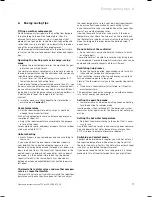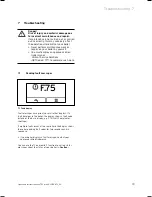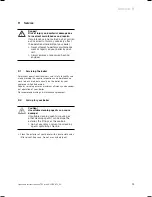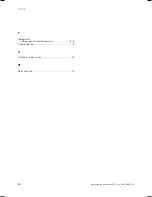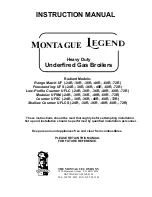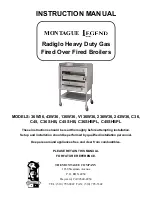
Energy saving tips
Operating instructions ecoTEC pro 0020129673_00
17
6
6
Energy saving tips
Fitting a weather compensator
Weather compensators regulate the heating flow tempera-
ture according to the outside temperature. Thus it is
ensured that heat in excess of what is required at that
moment is not generated. In addition, desired heating and
set-back phases (e.g. at night) are automatically turned on
and off by using integrated time programmes.
Weather compensators combined with thermostatic radia-
tor valves are the most economical form of heating regula-
tion.
Operating the heating system in energy-saving
mode
>
Reduce the room temperature for the night and for peri-
ods when you will be absent.
The simplest and most reliable way is to be able to reduce
the room temperature using the controller with individually
selectable timer programmes.
>
At such times, set the room temperature approx. 5 °C
lower than during full heating times.
If you reduce the room temperature by more than 5 °C, you
do not save any additional energy, because increased heat-
ing capacities would then be required for the next full heat-
ing period. Only for longer absences, e.g. during holidays, is
it worthwhile to lower the temperatures further.
Caution!
>
In winter, make sure that adequate frost protection is
maintained (
¬ Section 5.7
).
Room temperature
>
Set the room temperature only as high as would be
enough for your comfort level.
Each extra degree would cause an increased energy con-
sumption of about 6%.
>
Adjust the room temperature according to the purpose
of use of the room.
For example, normally, bedrooms or rooms that are seldom
used are heated to 20 °C.
Uniform heating
>
Heat all rooms in your dwelling evenly and according to
their use.
If you are only heating one room or individual rooms in
your dwelling, the unheated adjoining rooms are also
heated in an unregulated manner through walls, doors, win-
dows, roofs and floors. The capacity of the radiators in the
heated rooms is obviously not enough for such an operat-
ing mode. It is then not possible to heat up the heated
rooms sufficiently (the same effect arises when doors
between heated and unheated/partially heated rooms are
left open).
Thermostatic radiator valves and weather compen-
sators or room thermostats
Thermostatic valves on all radiators maintain the room tem-
perature exactly once they have been set. You can adjust
the room temperature to suit your individual requirements
and ensure effective operation of your heating system
using thermostatic valves in combination with a room ther-
mostat or a weather compensator.
How the thermostatic radiator valve works: If the room
temperature rises above the value set on the sensor head,
the thermostatic radiator valve shuts off automatically, and
when the temperature drops below the defined value, it
opens again.
Do not obstruct the controller
>
Do not obstruct your controller with furniture, curtains
or other objects.
The controller must be able to record the circulating room
air unhindered. Covered thermostatic radiator valves can be
equipped with remote sensors and thus still work.
Ventilating living rooms
>
During the heating period, open windows only for venti-
lation and not to regulate the temperature.
Brief ventilation is more effective and energy-saving than
leaving windows open for a long time.
Close all the thermostatic valves in the room during ventila-
tion.
>
If you have a room thermostat installed, set it to mini-
mum temperature.
This guarantees adequate exchange of air without unneces-
sary loss of energy and cooling off.
Setting the operating mode
>
In warmer seasons, when the dwelling needs no heating,
turn the heating to summer mode.
Heating mode is then switched off. The boiler and system
remain ready for operation for the domestic hot water gen-
eration.
Setting the hot water temperature
>
Only heat the warm water up to the extent that is neces-
sary for use.
Any further heating results in unnecessary power consump-
tion and domestic hot water temperatures of more than
60 °C also lead to increased limescale sediment.
Switching on Comfort mode
Comfort mode immediately supplies you with hot water at
the required temperature, without you having to wait for
the water to heat up. For this, the hot water heat exchanger
is kept at a preselected temperature level.
If you do not need hot water for a long period, it is recom-
mended to turn off comfort mode to save energy further.
Summary of Contents for ecoTEC pro
Page 29: ......
Page 30: ......
Page 32: ...0020129673_00 GBIE 092011 Subject to change Manufacturer Supplier...















